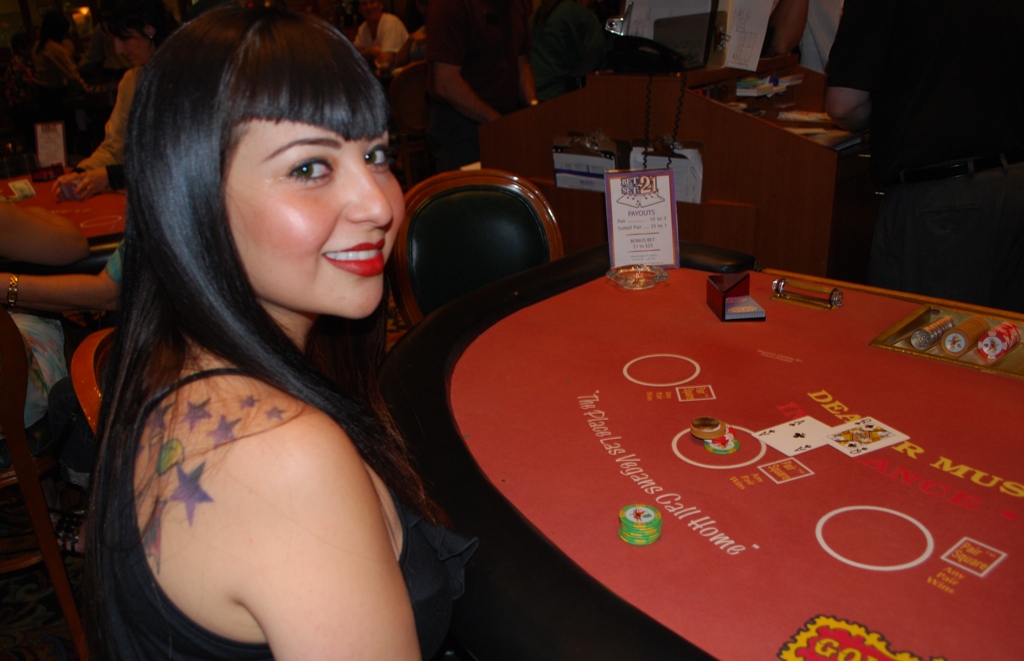On this page
Progressive Blackjack
Introduction
As the name implies, this is a blackjack side bet with a progressive jackpot. For an optional $1, the blackjack player may win $3 to the progressive jackpot, which starts at $25,000. I saw this side bet at the New York New York casino, where they had three tables tied into the same progressive.
Rules
Just like in Caribbean Stud, the player puts the $1 for the Progressive side bet in a slot. Before dealing a new hand, the dealer presses a button, the dollars vanish, and a light designates who made the bet. The following table shows what each winning hand pays, the probability (based on the dealer peeking for blackjack), and the contribution to the return.
On July 30, 2001, the jackpot meter was at $35,537.36. At this time, I was told they recently put it in place and nobody had hit the jackpot yet. On August 11 the meter had risen to $37,746.28.
The following table shows the return based on a meter of $35,537.36, the amount the last time I observed it.
Progressive Blackjack
| Hand | Permutations | Probability | Pays | Return |
|---|---|---|---|---|
| 4 red/black aces | 23760 | 0.000003 | 35537.36 | 0.090844 |
| 4 aces | 231264 | 0.000025 | 2000 | 0.049763 |
| 3 suited aces | 138240 | 0.000015 | 1000 | 0.014873 |
| 3 non-suited aces | 3359232 | 0.000361 | 200 | 0.072283 |
| 2 Suited aces | 10679040 | 0.001149 | 50 | 0.057447 |
| 2 non-suited aces | 38444544 | 0.004136 | 15 | 0.062043 |
| 1 ace | 662100480 | 0.071234 | 3 | 0.213703 |
| No aces | 8579718720 | 0.923077 | 0 | 0 |
| Total | 9294695280 | 1 | 0 | 0.560955 |
The above table shows an expected return of 56.10% per dollar bet, or a house edge of 43.90%. The general formula for the return is 47.01%, plus 2.56% for each $10,000 in the meter. To have no house edge, the meter would need to reach $207,287.85. Also note there are no basic strategy deviations for this side bet. If the player gets two aces, then he should split anyway, which guarantees two more cards.
It is unclear to me what events cause the meter to go up and down. Sometimes the meter goes up by 28 cents for each $1 bet made. According to the Mikohn's web site, the house edge is 22%. If this is the case, then the meter contribution rate is 24.60%. Mikohn also mentions that part of each dollar goes to a higher reseed of the next jackpot. So 24.60% would be divided between the current meter and the next one. Based on this contribution rate, the average jackpot when won would be $121,225.86.
Here is another version that has been seen at Internet casinos using Cryptologic software. The game uses eight decks of cards.
Progressive Blackjack — Cryptologic Version
| Hand | Pays | Permutations | Probability | Return |
|---|---|---|---|---|
| Four suited aces | Jackpot | 6720 | 0.00000023 | ? |
| Three suited aces | 2500 | 516096 | 0.00001748 | 0.043710 |
| Four aces unsuited | 1500 | 856320 | 0.00002901 | 0.043515 |
| Three aces unsuited | 250 | 10911744 | 0.00036966 | 0.092415 |
| Two suited aces | 100 | 35524608 | 0.00120348 | 0.120348 |
| Two aces | 25 | 121798656 | 0.00412620 | 0.103155 |
| All other | 0 | 29348718336 | 0.99425394 | 0.000000 |
| Total | 29518332480 | 1.00000000 | 0.403142 + ? |
Based on a $1 bet, this bet becomes break-even at $2,621,763.29. The general formula for the return is 0.403142 + jackpot/4,392,609.





